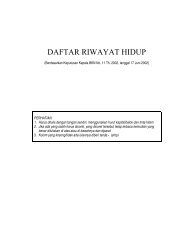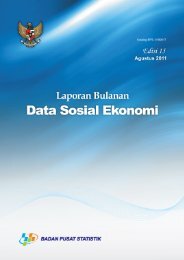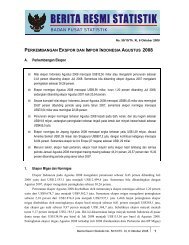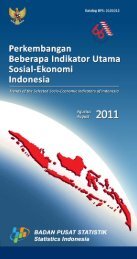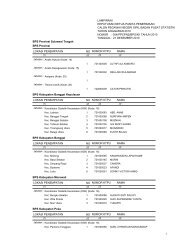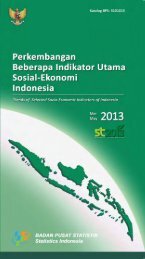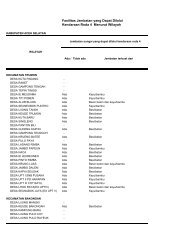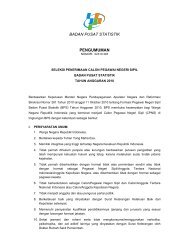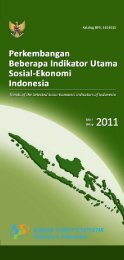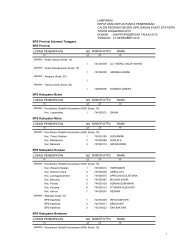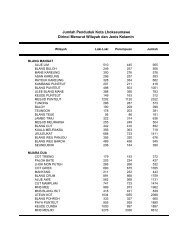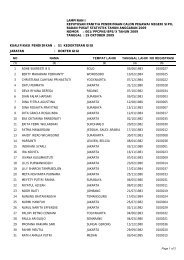Trends of Selected Socio-Economic Indicators of Indonesia, August ...
Trends of Selected Socio-Economic Indicators of Indonesia, August ...
Trends of Selected Socio-Economic Indicators of Indonesia, August ...
Create successful ePaper yourself
Turn your PDF publications into a flip-book with our unique Google optimized e-Paper software.
• Business Tendency Index is one indicator that can provide early information about the<br />
state <strong>of</strong> business and the economy in the short term. In the Business Tendency Survey<br />
in question is the development <strong>of</strong> the business world in general in the corresponding<br />
three months earlier than three months and the prospect <strong>of</strong> the next three months.<br />
• Consumer Tendency Index aims to get a picture <strong>of</strong> a business situation and general<br />
economic consumer opinion, based on consumer purchasing power and also on<br />
perceptions about business conditions and the economy.<br />
• Gross Domestic Product (GDP) is an important economic indicator to show the<br />
economic condition <strong>of</strong> a country at certain period in time. GDP is defined as the total<br />
value added <strong>of</strong> all production units in a certain country for a certain period (usually<br />
one year).<br />
• Per Capita Gross Domestic Product is GDP divided by the total mid-year population.<br />
• GDP at current prices shows the value added <strong>of</strong> goods and services at current prices<br />
for a certain year.<br />
• GDP at constant prices shows the value added <strong>of</strong> goods and services calculated at fix<br />
prices <strong>of</strong> a base year.<br />
• Household consumption expenditures consist <strong>of</strong> expenditures incurred by households,<br />
which are used for both individual or collective needs. Household consumptions are<br />
classified into food and non-food (goods and services) expenditures that may take<br />
place in domestic or abroad. Expenditures here include expenditures <strong>of</strong> Nonpr<strong>of</strong>it<br />
institutions serving households.<br />
• Government consumption expenditures consist <strong>of</strong> expenditures for the compensation<br />
<strong>of</strong> employees, capital consumption (depreciation) and intermediate consumption<br />
(including travel allowance, maintenance cost, and other routine expenditures) spent<br />
by either central or local government.<br />
• Gross fixed capital formation consists <strong>of</strong> resident producers acquisitions, less<br />
disposals, <strong>of</strong> fixed assets during a given period plus certain addition to the value <strong>of</strong><br />
non produced assets done by the productive activity <strong>of</strong> producer or institutional units.<br />
Fixed assets are tangible and intangible assets produced as outputs from processes<br />
<strong>of</strong> production that are used by themselves and repeatedly, or continuously in process<br />
<strong>of</strong> production for more than one year. The expenditure for military purposes are<br />
classified as government expenditure not as capital formation.<br />
• Exports <strong>of</strong> goods and services consist <strong>of</strong> transactions <strong>of</strong> goods and services from<br />
residents to non-residents.<br />
• Imports <strong>of</strong> goods and services consist <strong>of</strong> transaction <strong>of</strong> goods and services from nonresidents<br />
to residents. Exports and imports <strong>of</strong> goods occur when there are changes<br />
in ownership <strong>of</strong> goods between residents and nonresidents (with or without physical<br />
movements <strong>of</strong> goods across frontiers).<br />
• Growth rate <strong>of</strong> Gross Domestic Product (GDP) is derived from GDP at constant market<br />
prices. It is obtained by subtracting the value <strong>of</strong> GDP year n with the value <strong>of</strong> GDP year<br />
n-1, divided by the value <strong>of</strong> GDP year n-1 then multiplied by 100 percent. The growth<br />
rate <strong>of</strong> GDP explains the income growth during the given period.<br />
xxiv<br />
<strong>Trends</strong> <strong>of</strong> <strong>Selected</strong> <strong>Socio</strong>-<strong>Economic</strong> <strong>Indicators</strong> <strong>of</strong> <strong>Indonesia</strong>, <strong>August</strong> 2012



